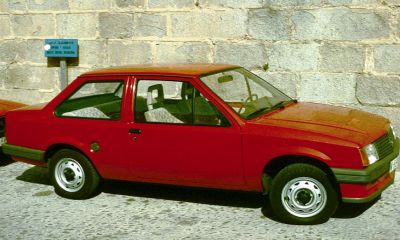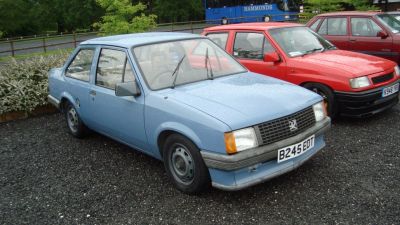 1970 Triumph Toledo Dimensions, Size & Specs
1970 Triumph Toledo Dimensions, Size & SpecsMeasurements of the 1970 Triumph Toledo, engineered for optimal performance and comfort
| Dimensions | |
|---|---|
| Length: | 3965 mm156.1 in13.0 ft |
| Width: | 1568 mm61.7 in5.1 ft |
| Height: | 1372 mm54.0 in4.5 ft |
| Trunk Capacity: | 303 liter10.7 cu ft |
| Weight Specifications | |
| Maximal permitted Weight: | 1240 kg2734 lbs |
| Tire Specifications | |
| Rims Size: | 13-inch rims:
|
The 1970 Triumph Toledo is a classic British sedan produced from 1970 to 1977, offering a compact and practical design for its era. Measuring 3965 mm (approximately 156.1 inches) in length, 1568 mm (61.7 inches) in width, and standing at a height of 1372 mm (54 inches), the Toledo is a compact sedan suited for city driving and comfortable family use. With a maximum weight of 1240 kg (2734 lbs), this vehicle balances manageable size with solid build quality typical of the Triumph marque. Its luggage capacity totals 303 liters (approximately 10.7 cubic feet), providing reasonable storage for a car of its class. The Toledo rides on 4J x 13 rims, further emphasizing its compact and nimble road presence. The combination of these dimensions places the Triumph Toledo in the smaller sedan segment of the 1970s, ideal for drivers seeking efficiency alongside British styling and engineering. These specifications make the Triumph Toledo a noteworthy example in size comparison charts among vintage sedans, blending moderate size with functional utility.
Discover the standout features that make the 1970 Triumph Toledo a leader in its class
Have a question? Please check our knowledgebase first.
The Triumph Toledo sedan, produced from 1970 to 1977, measures 3965 mm (approximately 156.1 inches) in length, 1568 mm (about 61.7 inches) in width, and stands 1372 mm (around 54.0 inches) tall. These compact dimensions made it a practical choice for city driving and easier maneuverability compared to larger sedans of its time.
The maximum weight of the Triumph Toledo from 1970 to 1977 is 1240 kg (approximately 2734 lbs). This relatively light weight for a sedan of its era contributed to responsive handling and better fuel efficiency. The lighter frame also helped improve acceleration and braking performance, enhancing overall driving dynamics.
The Triumph Toledo boasts a luggage capacity of 303 liters (about 10.7 cubic feet). For a compact sedan from the 1970s, this is a reasonable amount of cargo space, suitable for small to medium-sized luggage, grocery shopping, or day trips with the family. While not as spacious as modern sedans, it meets basic storage needs effectively.
The Triumph Toledo was equipped with 4J x 13 sized rims. These 13-inch wheels are relatively modest in size, which allowed for a comfortable ride quality with adequate absorption of road irregularities. Smaller rims like these typically contribute to softer suspension tuning and make for a smoother driving experience on uneven roads.
Yes, the Triumph Toledo’s compact dimensions make it suitable for parking inside a standard garage. With a length of 3965 mm (156.1 inches), width of 1568 mm (61.7 inches), and height of 1372 mm (54.0 inches), it comfortably fits in most typical residential garages, which generally accommodate vehicles around 2 to 2.5 meters in width and 5 to 6 meters in length.
The Triumph Toledo did not have a direct predecessor by the same name, as it effectively replaced the Triumph 1300 in the British Leyland lineup. Compared to the 1300, the Toledo was somewhat smaller and lighter, emphasizing a more compact form factor aimed at economy and practicality. This made the Toledo a more agile and economical option in the small sedan segment.
When compared to contemporaries such as the Ford Escort Mk1 or the Morris Marina, the Triumph Toledo is quite similar in size. The Escort Mk1, for example, measured roughly 3950 mm in length and 1560 mm wide, making the Toledo nearly identical in footprint. This placed it firmly in the compact car segment, offering similar interior space and maneuverability, with the Toledo often noted for its solid build and driving feel.
The Triumph Toledo, being a compact sedan from the 1970s, was designed with practical passenger comfort in mind. Despite its relatively modest exterior dimensions (3965 mm length, 1568 mm width), it offered a comfortable seating arrangement for four to five passengers. Headroom and legroom were adequate for its class, although taller passengers might find rear-seat space somewhat tight. The relatively roomy cabin compared to older small cars made it a popular choice for families and commuters alike.
The Triumph Toledo introduced several improvements over earlier models like the Triumph 1300. Mechanically, it featured rear-wheel drive with a simpler, more robust drivetrain. Styling was conservative but practical, with a focus on durability and ease of maintenance. The Toledo emphasized reliability and efficiency, making it a sensible choice amidst the turbulent economic conditions of the 1970s. Its suspension and chassis were tuned for better ride comfort compared to sportier Triumph models. Overall, it balanced economy with commendable build quality.
The Triumph Toledo is known for good mechanical simplicity and ease of maintenance, thanks largely to its straightforward rear-wheel-drive layout and conventional engine design. However, as a car produced in the 1970s, owners should keep an eye on potential rust issues, especially in the bodywork and chassis. Routine servicing of the carburetor, brakes, and suspension components is important to maintain reliability. Parts availability can be spotty but is generally supported by classic car communities and specialist suppliers. When maintained properly, the Toledo remains a reliable vintage vehicle with a charming blend of British motoring heritage.
Discover similar sized cars.

| Production: | 1982-1986 |
|---|---|
| Model Year: | 1982 |
| Length: | 3975 mm156.5 in |
| Width: | 1620 mm63.8 in |
| Height: | 1390 mm54.7 in |

| Production: | 1987-1990 |
|---|---|
| Model Year: | 1987 |
| Length: | 3955 mm155.7 in |
| Width: | 1540 mm60.6 in |
| Height: | 1360 mm53.5 in |

| Model Year: | 1983 |
|---|---|
| Length: | 3955 mm155.7 in |
| Width: | 1540 mm60.6 in |
| Height: | 1360 mm53.5 in |

| Production: | 1983-1993 |
|---|---|
| Model Year: | 1983 |
| Length: | 3955 mm155.7 in |
| Width: | 1541 mm60.7 in |
| Height: | 1358 mm53.5 in |
